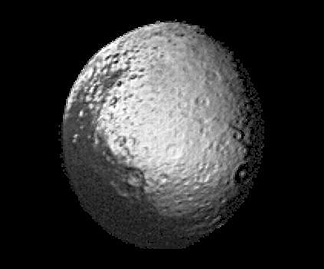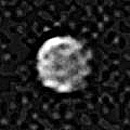
Rhea (1530 km [950 miles]) is very much like Dione in having a leading hemisphere that is heavily cratered, with densities comparable to the Moon and Mercury, as seen

in this close-up, and a trailing hemisphere with few craters, streaks (ejecta rays?), and fractures.

This same theme is repeated at Iapetus (1460 km [907 miles]) further out. The leading hemisphere has a very low albedo (0.03 -0.06) in sharp contrast, and with abrupt

boundaries, against the trailing edge (albedo ~ 0.5) terrain which is heavily cratered. The nature of this dichotomy is still speculative. This material may have emerged from within Iapetus during crustal foundering. But, the dark terrain is consistent with silicates having high carbon content, such as comprise carbonaceous chondrite meteorites. Thus, this part of Iapetus could have been captured as swept-up ejecta derived from another satellite or even infall of such an asteroid-like body.
Typical of appropriate small satellites is Phoebe (200 km ]134 miles] diameter), orbiting nearly 4x as far out as Iapetus.

Between Rhea and Iapetus is the large (5150 km [3198 miles]) satellite Titan which is a "maverick" among the icy group in that it is quite different in nature. The version

shown above has been enhanced to bring out more details - hence rendered in reds and yellows - than apparent in the natural color version that is a light brownish-yellow. Titan appears unlike the others because its surface is hidden by a dense atmosphere (with surface pressures of 1.5 atm, about 50% higher than Earth's). Details of this atmospheric structure are shown here:

This atmosphere consists of about 90% molecular nitrogen, 6% argon, with the remainder methane and organic derivatives such as hydrogen cyanide, ethane, acetylene, and CO2. Solar radiation breaks some of these constituents down into colored compounds analogous to urban smogs on Earth. Ammonia, now a trace constituent, may once have been more abundant until dissociating into carbon-nitrogen compounds.
What is below the clouds is uncertain. At Titan surface temperatures (- 179° C), the ethane may have condensed into a liquid "ocean" up to a kilometer in depth. Below this Titan probably consists of a layered mix of silicates and water ice. An infrared image acquired by the HST suggests several rises of material sticking out like "continents" (see yellow area in above image). This mysterious body (larger than Mercury and Pluto) - totally disparate compared to the other moons - may harbor organic molecules of unusual nature which cry out for study, as will be attempted by the future probe Huygens.
That probe is part of the Cassini mission. The Cassini (a 17th Century French-Italian astronomer who pioneered telescopic observations of Saturn) spacecraft was successfully launched from Cape Canaveral at 4 AM on October 15, 1997 to begin a 6.7 year journed to the Ringed Planet. The size of a school bus, this vehicle (managed by JPL with experiments from NASA, the European Space Agency, the Italian Space Agency, and other participants) will take a round-about trip to gain velocity by gravity assist "kicks". By passing Venus twice, then Earth again, and Jupiter later, their gravitational pull will increase the spacecraft's speed.
The Cassini Orbiter will explore Saturn's magnetosphere, its rings, its icy satellites, and will land on Titan. The Orbiter contain a variety of instruments including a magnetometer, visible imager, radar, UV and IR spectrometers, ion and mass spectrometers, a plasma spectrometer, a dust analyzer, and radio science instruments.
In November of 2004, a large probe will be released from the Orbiter to descend into the atmosphere of Titan onto its surface. Named Huygens (a Dutch astronomer who discovered this large satellite), the probe will use a large parachute deployed at 175 km (110 miles) to slow its fall, then, after jettisoning that, a small parachute to make the final drop onto a surface, postulated to likely be liquid but if solid then the probe should survive the landing. The Huygens probe will carry a descent imager, spectral radiometer, a Doppler wind measuring device, an aerosol collector, a Gas Chromatograph, a Mass Spectrometer, and a surface science package.
Cassini, which cost in excess of a billion dollars (and raised protests from some environmentalists fearful of its 77 grams of plutonium that will serve as a power source), is the most sophisticated and ambitious probe yet sent to explore the planets.
Code 935, Goddard Space Flight Center, NASA
Written by: Nicholas M. Short, Sr. email: nmshort@epix.net
and
Jon Robinson email: Jon.W.Robinson.1@gsfc.nasa.gov
Webmaster: Bill Dickinson Jr. email: rstwebmaster@gsti.com
Web Production: Christiane Robinson, Terri Ho and Nannette Fekete
Updated: 1999.03.15.